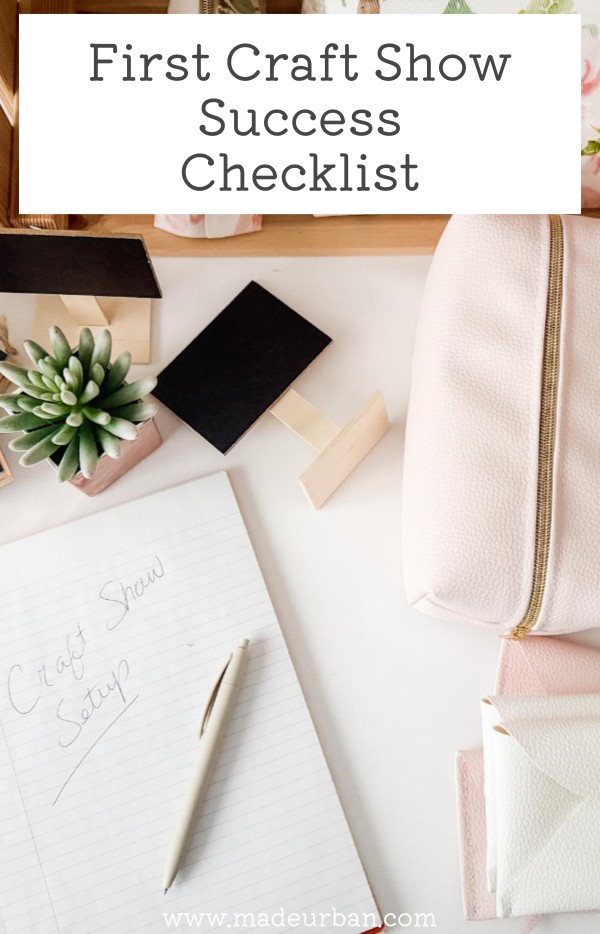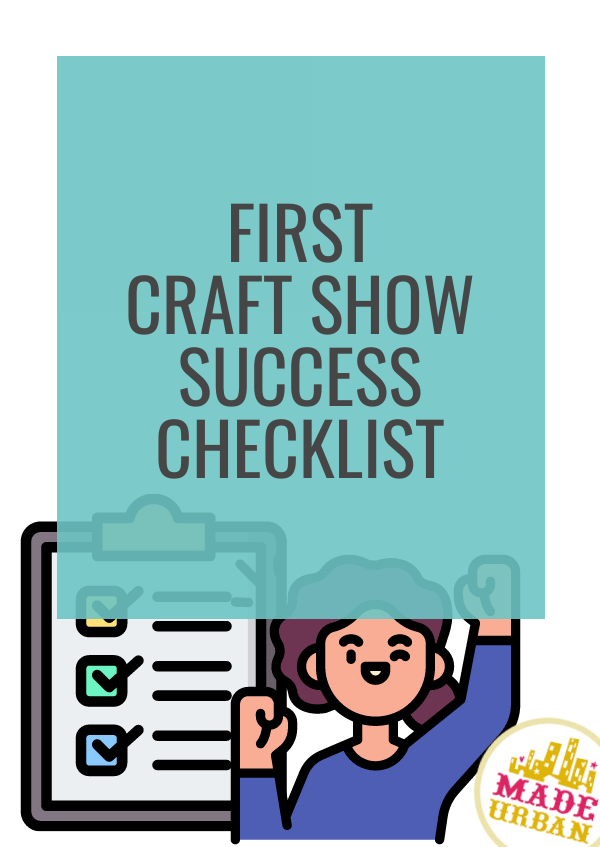First Craft Show Success Checklist
Craft shows can be profitable, but they require planning. It’s not enough to just show up with your products, place them on a table, and wait for shoppers to buy.
There’s a lot to think about, from how much stock to bring to how to display all that stock.
But every craft show vendor starts exactly where you are.
This checklist will guide you through the essential steps, ensuring you’re not only prepared but also feel confident and excited for the big day.

Step 1 – Choose the right craft show
Not every craft show will be a fit for your business. Even if it’s small and free or big and popular, it doesn’t mean you should participate.
- Visit events – get an idea of what craft shows are all about and which types of booths tend to be the most popular. Take note of displays, price points, the way vendors interact with shoppers, etc.
- Start small and local – the first few markets will be a learning experience, so it’s best to try a smaller event that doesn’t require you to travel far.
- Find your target market – think about the type of customer who is a perfect fit for your products and look for craft shows that are likely to attract more of that type of customer.
Step 2 – Prepare your products
You want your craft show table/booth to look like a specialty store, not a department store. A curated selection of niche products will outperform a wide range of products in various styles.
- Start small – with each event, you’ll learn what sells and what doesn’t, and what’s the best fit for your target market. A booth selling one type of product (e.g. heating pads) can be more popular (and typically more profitable) than a booth selling several different products. Stick to one category, subcategory, or even niche of product.
- Vary price points – ideal price points vary from show to show, but generally, craft show shoppers spend in the $20 – $30 range, so try to have products within that price range. It’s also a good idea to have products that are priced higher and lower than your average price points.
- Stacking – plan your products so that shoppers can “stack” onto their purchases. If you sell jewelry, oven mitts, and pillows, no one is going to buy multiple items. On the other hand, if you sell oven mitts, tea towels, and aprons, shoppers are more likely to buy the apron that matches the oven mitts.
Step 3 – Plan your display
Your display will evolve with each event, and it doesn’t have to be extravagant to start. The key points to keep in mind are:
- Cohesion – you don’t need to spend a lot on craft show fixtures, but try to keep the finishes and style consistent. You might spray mismatched fixtures the same color, or stick to wood crates (here are creative ways to use crates). Simply sticking to a white tablecloth and white fixtures can allow your products to shine and give your space a cohesive and professional look.
- Height – finding a way to add levels and height to your display will make it more likely to catch shoppers’ eyes and will give you more space to display products.
- Shoppability – whatever fixtures you choose, make sure they make it easy for people to shop. If shoppers feel something might fall over if they touch, or they must move 5 items to get to the one they’re interested in, they’ll be less likely to touch.
Step 4 – Prepare to sell
You will need to interact with shoppers, beyond saying hello and asking if they have any questions.
- Conversation – craft shows are about making connections and often, selling feels more authentic and is more effective when you can simply have a conversation with a shopper (and work your products into it). Think about some open-ended questions (here are several examples) you can ask shoppers when they first approach your table and aren’t quite ready for a sales pitch.
- Selling points – think about what shoppers are most likely to care about when it comes to your products. These are the selling points you’ll want to highlight in signage and during conversations.
- Discounts – be prepared for shoppers to ask for discounts, so you don’t end up agreeing to a deal you later regret. This article will help: 6 Ways to Handle Craft Show Shoppers Asking for Discounts
Step 5 – Prepare for sales
Payment options – fewer and fewer people carry cash, so it’s a good idea to accept credit card and debit card payments. There are lots of options to do so. Research which will work for you. You should also be ready for people who want to pay cash and have plenty of smaller bills and coins so you can give change.
- Pricing – craft show shoppers do not want to ask “how much is this?”. Add price tags to each item. If your products aren’t ideal for adding price tags, be sure to group like items together and use signage so there’s no confusion.
- Packing purchases – some people may want a bag for their purchase, so make sure you have shopping bags on hand. It’s not necessary at your first craft show, but if you have marketing material (e.g. business cards, flyers, free samples), organize that so you can stuff it in each shopping bag.
- Tracking sales – any information you gather from a craft show will be beneficial for growing your business and improving at the next event. At a minimum, track what you’ve sold. How many of each type of product you sell, and important details (e.g. sold 5 red and 1 blue). 7 Stats to Track at Craft Shows (to improve sales)
Step 6 – Promote
It is the organizer’s job to market the event, but an event is much more successful when every vendor does their part to help spread the word. It’s also important to treat craft shows as a marketing opportunity.
- Before – share the event with friends and family, and ask them to let people they know about it. If you have social media accounts, post about the event and tag the event’s social media account. The organizer will appreciate the shout-outs. How to Promote a Craft Show (as a vendor)
- During – most shoppers won’t buy from you. But of those people, some may eventually become your customer. So be sure to hand out business cards, get people on your newsletter list, or to follow you on social media. That way, they can find you after the event and/or you can stay in contact with them. 6 Marketing Mistakes Craft Show Vendors Make
Step 7 – Packing
Get organized so you can get you and your products to the event and into the venue in a timely and efficient manner.
- Bins – think about how you will efficiently transport your products to and from the event. You need them to be protected during transport and not require you to make too many trips from your car to the venue.
- Food/drink – you can reduce craft show expenses by packing snacks, a lunch, and drinks for the day. Keep in mind, unless you have a helper, you won’t get a true lunch break. You’ll likely need to take quick bites between shoppers being at your table.
- Directions and parking – the mornings of craft shows can be hectic. And the last thing you want to do is get lost or spend several minutes looking for parking. Make sure you know where you’re going and have a plan for where to park.
No matter how much you prepare, your first craft show will be a learning experience.
If you’re reading this article, you’re going into your first craft show more prepared than I was, and than a lot of other vendors.
Remember to have fun, roll with the punches, and always look for ways to improve for the next one.


Hey, I’m Erin 🙂 I write about small business and craft show techniques I’ve learned from being a small business owner for almost 2 decades, selling at dozens of craft shows, and earning a diploma in Visual Communication Design. I hope you find my advice helpful!
